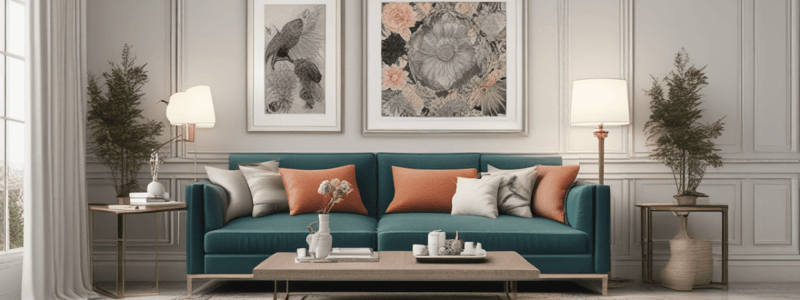Podcast
Questions and Answers
What is the primary purpose of chair molding in a room?
What is the primary purpose of chair molding in a room?
- To provide a structural support to the walls.
- To hide imperfections in the walls.
- To draw the eye and enhance visual appeal. (correct)
- To increase the room's insulation.
Which of the following is essential for creating a cohesive aesthetic in a room using moldings?
Which of the following is essential for creating a cohesive aesthetic in a room using moldings?
- Selecting moldings based solely on their price.
- Maintaining consistency in color and style. (correct)
- Incorporating multiple molding types randomly.
- Using various contrasting colors.
What are wainscot panels commonly used for?
What are wainscot panels commonly used for?
- To cover entire walls with vibrant colors.
- To complement other wooden elements in a room. (correct)
- To frame windows and doors for a modern look.
- To serve as a temporary wall covering.
In which areas are wood paneling most commonly found?
In which areas are wood paneling most commonly found?
What deters some individuals from choosing wood paneling?
What deters some individuals from choosing wood paneling?
Flashcards are hidden until you start studying
Study Notes
Wall Decoration Options
- Wall embellishments extend beyond paint, including fabric, tiles, and wood, each providing a unique aesthetic.
- Rich fabric covering adds a luxurious feel, while wood paneling brings warmth and texture.
- Tile can create a modern look and is ideal for high-moisture areas due to its hygiene and maintenance benefits.
Painting Techniques
- Painting is a cost-effective, time-efficient way to revitalize spaces, using oil-based or water-based (latex) paints.
- Gloss finishes are suitable for high-traffic areas, while flat or semi-gloss finishes are better for primary living areas due to their ability to mask imperfections.
- Decorative faux techniques, like ragging, sponging, and dragging, add depth and personality to painted walls.
Faux Finish Methodologies
- Ragging On: Apply a glaze with a damp rag over a dried base coat for textured effects.
- Sponging: Use a damp sponge to dab glaze onto the base coat, creating unique outcomes.
- Sponging Off: Similar to the above but involves blotting to reveal texture.
- Dragging: Achieve an antique look by dragging a brush through wet glaze over the base coat.
- Combing: Use a toothed implement to create patterns and textures.
- Color Washing: Apply glaze with random strokes for a worn look, layering colors for depth.
- Spattering: Flick glaze for an artistic effect, varying colors and intensity for visual interest.
Wall Coverings
- Wallpapers offer various patterns and textures and can conceal surface imperfections.
- Vinyl wallpapers are durable for high-traffic areas; hand-printed options provide artisanal charm.
- Natural fiber wallpapers, like grass cloth and linen, introduce organic aesthetics.
Fabric Wall Decorations
- Fabric enhances texture and warmth, providing a customizable aesthetic that can conceal wall irregularities.
- Materials range from casual linens and cottons to luxurious silks, suitable for different moods and spaces.
- Installation may be labor-intensive and costly but can result in stunning outcomes.
Tile Use
- Tiles come in materials like ceramic, stone, and mosaic, ideal for kitchens and bathrooms.
- They offer visual appeal and a decorative touch while being hygienic and easy to maintain.
- Long-term durability justifies the initial cost for many homeowners.
Trim and Moldings
- Trim elements like chair rail, crown moldings, and baseboards provide a refined finish to walls.
- Consistent color and style across moldings are necessary for a cohesive aesthetic.
Wood in Wall Design
- Wood paneling or wainscoting adds natural warmth and sophistication to rooms.
- Its insulating properties and ability to conceal imperfections are valuable in formal spaces.
- Higher costs can deter use compared to other wall covering options, but its elegance may be worth the investment.
Studying That Suits You
Use AI to generate personalized quizzes and flashcards to suit your learning preferences.




